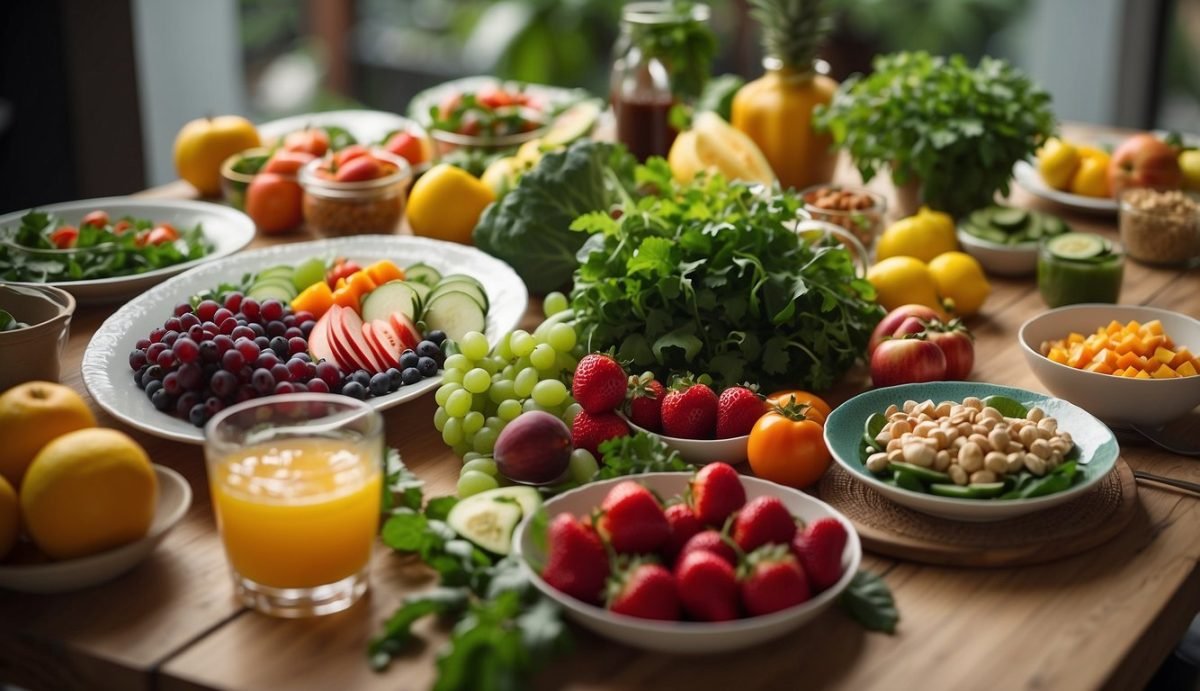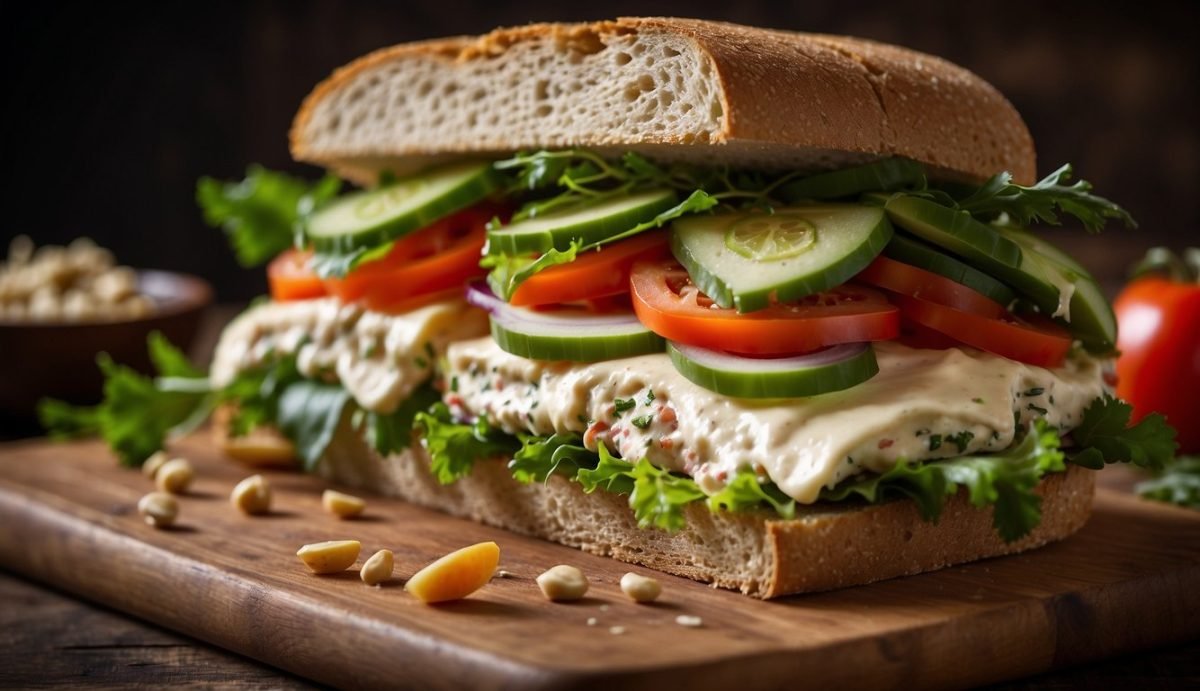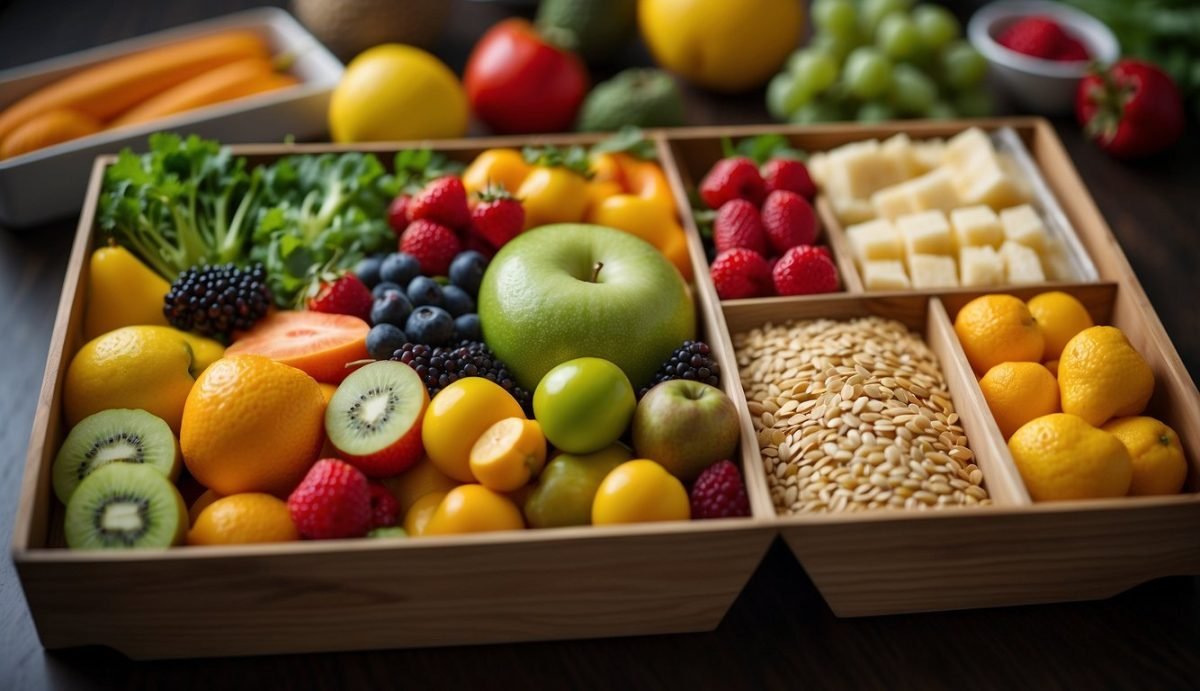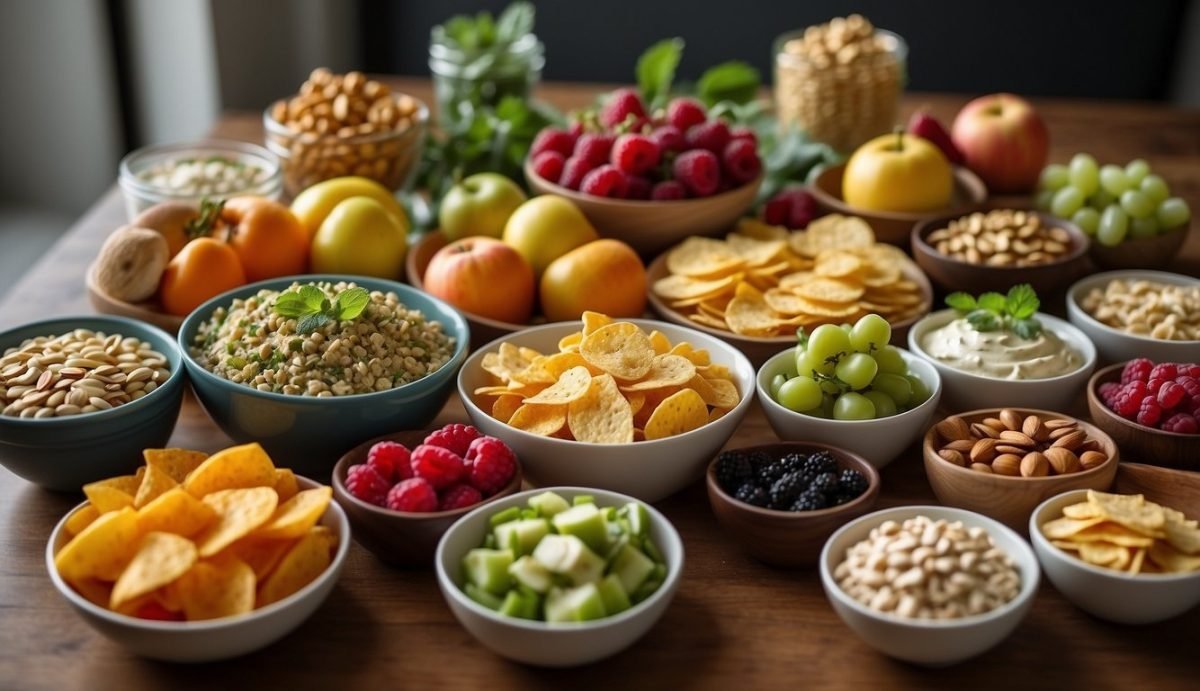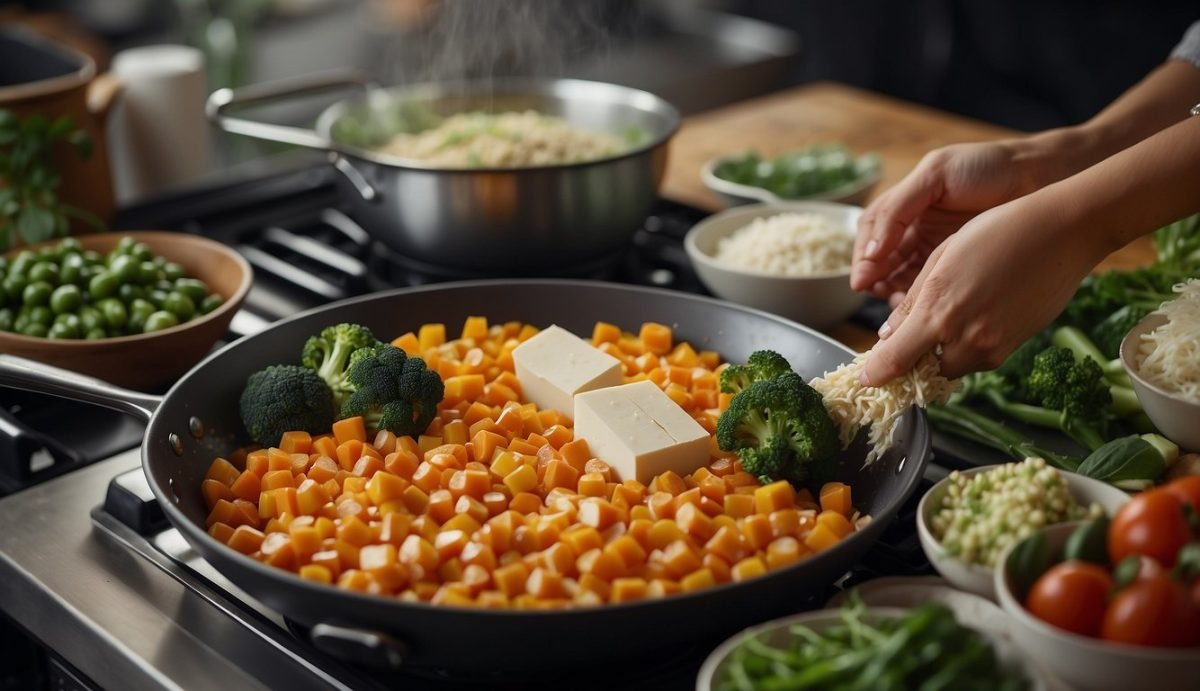Eating a vegan diet doesn’t mean missing out on protein. I’ve gathered 13 high-protein vegan meal ideas to show you just how easy and delicious it can be to fuel your body without using animal products. Whether you’re new to plant-based eating or a long-time vegan, this list is for you.

These meals are packed with nutritious ingredients that will keep you satisfied and energized. From breakfast to dinner, there’s something here for everyone. Let’s make plant-based eating both tasty and nourishing together.
1. Chickpea and Quinoa Salad
I love making a Chickpea and Quinoa Salad for a hearty and healthy meal. It’s packed with protein and super easy to make.
All you need are some cooked quinoa, chickpeas, and fresh veggies like tomatoes and cucumbers. I like to add a bit of red onion for an extra kick.
To flavor the salad, I mix in olive oil, lemon juice, salt, and pepper. Sometimes, I also add some cumin or garlic powder for a little extra taste.
You can prepare this salad in advance and store it in mason jars for an easy grab-and-go option. Just mix everything before eating.
For some added crunch, try tossing in some hemp seeds or pomegranate seeds. They give a nice texture and more nutrients.
This salad is versatile and you can switch up the veggies based on what’s in season or what you have at home. It’s perfect for meal prepping and stays fresh in the fridge.
If you’re looking for a quick and simple dish, this Chickpea and Quinoa Salad is a great choice. Check out this easy recipe and give it a try.
2. Tempeh Stir-Fry
I love making Tempeh Stir-Fry because it’s quick, easy, and packed with protein. For this dish, I start by cutting tempeh into cubes. You can marinate the tempeh overnight, but even a quick 30 minutes works wonders.
I heat up sesame oil in a large skillet and add the tempeh cubes. Cooking the tempeh until it’s golden brown takes about 5-6 minutes. Once the tempeh is done, I set it aside.
Next, I add more oil to the skillet and toss in my favorite vegetables. Broccoli, bell peppers, and carrots are my go-to choices. They cook quickly, staying crisp and colorful.
For the sauce, I mix soy sauce, garlic, ginger, and a touch of maple syrup. It’s both savory and slightly sweet. I pour the sauce over the veggies and let it simmer for a couple of minutes.
« 13 Vegan Sandwich Ideas: Delicious and Easy Recipes for Every Meal
17 Vegan Bento Box Ideas: Delicious and Easy Meal Prep »
Finally, I add the tempeh back to the pan, giving everything a good stir until it’s well-coated. The result is a delicious, protein-rich meal that’s ready in under 30 minutes.
For added flavor, I sometimes top it with chopped green onions and sesame seeds. This Tempeh Stir-Fry is perfect over a bed of rice or noodles.
For more detailed instructions, you can visit the Minimalist Baker recipe or check out another version at Plant-Based on a Budget.
3. Lentil Tacos

Lentil tacos are one of my favorite high-protein vegan meals. They’re not just tasty, they’re also packed with nutrients. I love that lentils are a great meat substitute because they’re hearty and full of protein.
To start, I heat some olive oil in a skillet. I usually add chopped onions and garlic first. The aroma is incredible as they cook together. Next, I mix in spices like cumin, chili powder, and oregano. These spices give the tacos a wonderful kick.
Once the onions and garlic are tender, I add cooked lentils and a bit of vegetable broth. I let this simmer until the lentils absorb the flavors and the mixture thickens. Sometimes, I also add cauliflower rice for an extra veggie boost.
For the taco shells, I either use soft corn tortillas or crunchy taco shells, depending on my mood. I then spoon the lentil mixture into the shells. Toppings are a must! I usually add avocado slices, diced tomatoes, and fresh cilantro.
These vegan lentil tacos are perfect for a family dinner or even meal prep. They’re delicious, healthy, and super easy to make!
4. Tofu Scramble
One of my favorite high-protein vegan meals is tofu scramble. It’s super easy to make and tastes great. First, drain and crumble the tofu into bite-sized pieces.
To give it that egg-like flavor, I add nutritional yeast, garlic, onion powder, turmeric, and a pinch of Kala Namak. The turmeric gives it a nice yellow color, just like scrambled eggs.
I usually heat some olive oil in a pan over medium heat. Then, I sauté the crumbled tofu until it’s hot, which takes about 8-10 minutes.
Sometimes, I mix in extra ingredients like bell peppers, onions, or kale. It’s a great way to get more veggies in my diet.
When I’m feeling adventurous, I might add some chickpeas and cherry tomatoes. A dash of lemon juice brightens up the flavor.
Tofu scramble is perfect for breakfast or even a quick lunch. Plus, it’s packed with protein and really filling.
For detailed recipes, I find sites like Karissa’s Vegan Kitchen and The Full Helping very helpful.
5. Vegan Protein Smoothie
One great way to get a protein boost is with a vegan protein smoothie. I enjoy making these for a quick breakfast or post-workout snack. They are easy to prepare and packed with nutritious ingredients.
For instance, you can try an avocado spinach smoothie. It has 292 calories and 14 grams of protein per serving. It’s a great mix of healthy fats and greens.
Another tasty option is a peanut butter cacao shake. This delicious shake offers over 20 grams of protein without using any protein powder. It’s creamy and chocolatey, perfect for satisfying a sweet tooth.
I also like using pea protein in my smoothies. One of my favorites includes 1 1/2 tablespoons of pea protein, along with banana, vanilla extract, and oat milk. This combination makes a smooth, protein-packed drink.
Adding hemp hearts can also boost your smoothie’s protein content. They are a protein powerhouse and can be mixed with sunflower seeds for added flavor and nutrients.
If you want to explore more recipes, you can find great ideas on websites like Hurry the Food Up and Vegan Fit Guide. These sites offer a variety of creative and healthy vegan protein smoothies.
Making these smoothies has become a fun and easy way for me to ensure I get enough protein during the day. Give one a try, and you might just find your new favorite drink!
6. Black Bean Chili
I love making Black Bean Chili when I need a hearty and protein-packed meal. It’s perfect for a chilly evening or just whenever I crave something warm and comforting.
First, I start by heating a bit of olive oil in a large pot. Then, I add chopped onions, garlic, and bell peppers. Sautéing these until they’re soft makes the whole kitchen smell amazing.
Next, I pour in crushed tomatoes, canned black beans (with the liquid), and some green chilies. For seasoning, I add chili powder, cumin, and a pinch of salt. It’s important to let the chili simmer so all the flavors have time to blend together.
I sometimes mix in other veggies like corn or even sweet potatoes for extra texture and nutrition. This dish is versatile and easy to adapt based on what I have on hand.
For a quicker version, you can check out a simple 3-ingredient vegan black bean chili recipe. It’s great when you’re short on time and still want something tasty.
When serving, I like to garnish it with fresh cilantro and a squeeze of lime juice. A dollop of vegan sour cream on top can make it even more delicious.
7. Vegan Shepherd’s Pie
I absolutely love making Vegan Shepherd’s Pie. It’s a hearty and comforting dish packed with protein and flavor. For this recipe, I use lentils or textured vegetable protein (TVP) as the base.
First, I sauté onions, garlic, and mushrooms until they are soft. Then, I add in my TVP or lentils, along with vegetable broth, nutritional yeast, and a mix of seasonings like thyme, basil, and smoked paprika.
Once the filling is ready, I transfer it to a pie dish. On top of the veggie mixture, I spread a layer of creamy mashed potatoes. For an extra touch, I like to dot the potatoes with vegan butter and sprinkle some black pepper on top.
To finish, I bake it in the oven until the top is golden brown and crispy. This dish is perfect for a cozy dinner, and it makes great leftovers too.
Check out this vegan shepherd’s pie recipe for more detailed instructions.
8. Peanut Butter Protein Bars

I love making peanut butter protein bars. They are easy and quick to prepare and great for a snack or breakfast.
First, I line a baking dish with parchment paper. Then, I mix peanut butter, maple syrup, mashed banana, vanilla extract, protein powder, flax meal, oats, crispy rice cereal, and a pinch of sea salt in a bowl.
Once mixed, I fold in chocolate chips. This gives the bars a yummy, sweet touch.
Next, I spread the mixture in the lined baking dish. I press it down firmly with a flat-bottomed object, like a drinking glass.
Then, I pop it into the freezer for about 10-15 minutes to let it firm up before cutting it into bars.
I sometimes try different add-ins like chia seeds or dates, as suggested in this recipe.
These bars are not only vegan but also packed with protein and easy to grab when I’m in a rush.
9. Edamame Hummus
I love making edamame hummus because it’s easy and tasty. To start, boil edamame in salted water for about five minutes. Then, drain and toss them into a food processor.
Next, add tahini, lemon juice, garlic, water, and cumin to the processor. I like to drizzle in some olive oil while it’s blending. This helps to make it extra smooth and creamy.
Sometimes I like adding a bit of za’atar seasoning for an extra kick. If you can’t find za’atar, paprika and salt work fine too.
Blending the hummus until smooth may take a couple of minutes. I scrape down the sides as needed to make sure everything is well mixed.
Once it’s all blended, I taste it to check the seasoning. Often, a bit more lemon juice or salt might be needed.
After that, I transfer the hummus to a bowl and often drizzle a bit more olive oil on top. It’s perfect for dipping veggies, spreading on toast, or even using in sandwiches.
Edamame hummus is not just delicious but also packed with protein, making it a great choice for a healthy snack. You can find the full recipe here.
10. Vegan Protein Pancakes
I love starting my day with vegan protein pancakes. They are fluffy, filling, and packed with nutrients. To make them, mix flour, protein powder, baking powder, salt, and a bit of sugar in a bowl.
In another bowl, combine dairy-free milk, water, oil, and vanilla. Slowly add the wet ingredients to the dry mixture, stirring gently until just combined. It’s okay if there are some lumps.
Let the batter sit for about 10 minutes. This helps make the pancakes extra fluffy. Cook the pancakes on a greased nonstick skillet over medium heat. Drop small ladles of batter into the pan.
Making smaller pancakes helps them cook evenly. Flip them when bubbles form on the surface and the edges look set. Cook until both sides are golden brown.
If you want more ideas, there’s a great guide on fluffy vegan protein pancakes that offers some variations. You can also find a recipe for vegan protein pancakes that boasts over 30 grams of protein per serving.
These pancakes are versatile. Top them with fresh fruit, nuts, or a drizzle of maple syrup. They make a hearty breakfast and are perfect for a weekend brunch. Give them a try, and you might find they become a new favorite.
11. Seitan Tacos
Seitan tacos are a tasty and high-protein meal that I love to make. They are perfect for a quick lunch or dinner. Seitan, made from wheat gluten, has a chewy texture that’s great for tacos.
I usually start by sautéing seitan in a bit of oil until it’s nice and browned. Then, I mix in some taco seasoning to give it that classic taco flavor. Sometimes, I like to add some soy sauce, chipotle, paprika, cumin, and chili powder for an extra kick.
Once the seitan is cooked and seasoned, it’s time to assemble the tacos. I love using soft tortillas and piling them high with the seitan mixture. For toppings, I usually go for fresh veggies like lettuce, tomatoes, and avocado.
A squeeze of lime and a sprinkle of cilantro really elevate the flavor. These tacos are not only delicious but also packed with protein. If you’re looking for a hearty and satisfying vegan meal, you should definitely give seitan tacos a try. You can find a great recipe for Easy Vegan Tacos if you need some guidance.
12. Chia Seed Pudding
One of my favorite go-to breakfasts or snacks is chia seed pudding. It’s super easy to make and incredibly satisfying. All you need are chia seeds, non-dairy milk, and a bit of sweetener if you like.
I love using mason jars to prep my chia seed pudding. Just add 2-3 tablespoons of chia seeds to a jar, pour in about a cup of almond or soy milk, and stir well. You can also throw in some vanilla extract or maple syrup for extra flavor.
If you’re in a hurry, blend all the ingredients in a high-speed blender to get a smoother texture. After blending, just pop it in the fridge for at least an hour or overnight. By morning, it’s thick and ready to enjoy!
Feel free to get creative with toppings. Fresh fruit, nuts, seeds, or even coconut shreds add a nice touch.
This versatile dish is not only delicious but also packed with nutrients like fiber, protein, and omega-3 fatty acids. For more tips and a detailed recipe, you can check out this high protein chia pudding recipe from The Conscious Plant Kitchen.
13. Vegan Lentil Soup
I love making vegan lentil soup because it’s delicious and packed with protein. I start by heating a large pot over medium heat. I add some garlic, onions, carrots, and celery.
Next, I mix in cumin, paprika, and a bit of salt. After that, I add tomato paste and cook it for a minute. Then I stir in crushed tomatoes, lentils, and vegetable stock.
I bring the soup to a boil and then reduce the heat to let it simmer for about 30-35 minutes. This helps the lentils get tender. Sometimes I also add some kale towards the end and cook it until it’s wilted.
Finally, I add some flax seed and adjust the seasonings if needed. The result is a hot, flavorful, and high-protein meal. I like to serve it fresh, but it also keeps well for meal prepping.
For more details, you can check out the High Protein Lentil Soup recipe from Vegan Cocotte or this 1-Pot Vegan Lentil Soup recipe from Minimalist Baker.
Nutritional Benefits of High Protein Vegan Meals

High protein vegan meals offer essential macronutrients and micronutrients, support numerous health benefits, and challenge common myths about the adequacy of vegan protein sources.
Macronutrients and Micronutrients
In high protein vegan meals, you get important macronutrients like proteins, fats, and carbohydrates. Foods such as quinoa and black beans are rich sources of plant-based protein. They also provide essential amino acids, which are the building blocks of protein.
High protein vegan foods are also packed with vital micronutrients. For example, almonds and hemp seeds are good sources of iron and magnesium. These elements help in muscle function and energy production. Additionally, many plant-based proteins like kale and broccoli are full of vitamins A, C, and K, supporting overall health.
Eating a variety of these foods ensures you get a comprehensive range of nutrients.
Health Benefits
Eating high-protein vegan meals can significantly benefit health. First, they help in muscle building and repair. If you’re active or into fitness, proteins from sources like tofu and lentils can help you recover faster after exercises.
These meals are often lower in saturated fats compared to animal proteins. This can help in better heart health. Foods like chia seeds and almond butter can also improve blood cholesterol levels.
Plant-based proteins are usually high in fiber, aiding in digestion and keeping you full longer. This can help with weight management as well.
Common Myths About Vegan Protein
There are many myths about vegan protein that I often hear. One is that you can’t get enough protein on a vegan diet. This is simply not true. Foods like kidney beans and peanut butter are very good protein sources and easily meet daily needs.
Another myth is that plant-based proteins are not complete proteins. While some vegan proteins may lack certain amino acids, eating a variety of foods like quinoa and soy products throughout the day covers all essential amino acids.
People also think vegan meals are difficult to prepare or lack flavor. Recipes, such as the ones for stuffed bell peppers or black bean soup, are both simple and delicious, proving this myth wrong.
Essential Ingredients for High Protein Vegan Meals

When creating high protein vegan meals, using a variety of ingredients ensures you’re getting all the necessary nutrients. Think about plant-based protein sources, protein-rich vegetables, and legumes for a balanced diet.
Plant-Based Protein Sources
Incorporating plant-based protein is essential for vegan meals. Some of my favorites include tofu, tempeh, and seitan. Tofu, made from soybeans, is incredibly versatile and can be used in stir-fries, soups, or even grilled. Tempeh, also from soybeans, has a firmer texture and a slightly nutty flavor, making it perfect for sandwiches or salads. Seitan, which is wheat gluten, is great for mock meats like vegan chicken or beef.
Common plant-based protein sources:
- Tofu: 10 grams of protein per 100 grams
- Tempeh: 19 grams of protein per 100 grams
- Seitan: 25 grams of protein per 100 grams
These ingredients not only provide protein but also texture and flavor to your dishes.
Protein-Rich Vegetables
Vegetables can also be a good source of protein. Broccoli, spinach, and kale are some of the top contenders. For example, broccoli provides around 2.8 grams of protein per cup. Spinach and kale, both leafy greens, are packed with nutrients and offer about 2-3 grams of protein per cup. These veggies can be added to smoothies, salads, or used as side dishes.
Protein content in vegetables:
- Broccoli: 2.8 grams per cup
- Spinach: 3 grams per cup
- Kale: 2 grams per cup
So, don’t underestimate the power of vegetables in boosting your daily protein intake.
Legumes and Pulses
Legumes and pulses are a staple in any high protein vegan diet. Black beans, lentils, and chickpeas are particularly high in protein. Black beans offer about 15 grams of protein per cup, making them great for soups and stews. Lentils, with 18 grams of protein per cup, are versatile and can be used in salads or stews. Chickpeas, which provide 14.5 grams of protein per cup, are fantastic in hummus, salads, or roasted as snacks.
Protein content in legumes and pulses:
- Black beans: 15 grams per cup
- Lentils: 18 grams per cup
- Chickpeas: 14.5 grams per cup
Using these ingredients will not only meet your protein needs but also add variety and richness to your meals.
Tips for Cooking and Preparing High Protein Vegan Meals
When you’re cooking high protein vegan meals, a little planning goes a long way. Using tips for meal prep, cooking techniques, and ingredient substitutes can make your meals tastier and more nutritious.
Meal Prep and Planning
I always start by planning my meals for the week. This helps me stay organized and ensures I have enough protein in each meal. I like to choose recipes that include versatile ingredients like chickpeas, lentils, and quinoa. These can be used in various dishes, saving time and effort.
Preparing meals in bulk is a game-changer. On Sundays, I cook big batches of grains and beans. I also chop veggies and store them in the fridge. This way, assembling meals during the week is quick and easy.
Having a shopping list is essential. It ensures I get all the necessary ingredients in one trip. I make sure to include high protein options like tofu, tempeh, and seitan. This planning not only saves time but also helps reduce food waste.
Cooking Techniques for Maximum Flavor
Using different cooking techniques can really boost the flavor of my vegan meals. For instance, roasting veggies brings out their natural sweetness, while sautéing with garlic and onions adds depth to the dish. I often use these methods to enhance the taste of my high protein ingredients.
Marinating is another technique I love. Tofu and tempeh absorb flavors well when marinated. I usually let them sit in a mix of soy sauce, lemon juice, and spices for at least an hour before cooking. This makes my meals much more flavorful.
I also experiment with spices and herbs. Smoked paprika, cumin, and fresh herbs like cilantro or basil can transform a simple dish into something special. Adding these seasonings at the right stage of cooking can make a big difference.
Easy Substitutes for Common Ingredients
Finding the right substitutes can make vegan cooking easier and more enjoyable. I often replace eggs in recipes with chia or flax seeds mixed with water. This works great in baking and even some savory dishes.
For protein, I switch out meat with plant-based options. Instead of chicken, I might use tofu or tempeh. Lentils and chickpeas can replace ground beef in recipes like tacos or chili. These swaps not only increase protein but also add variety to my diet.
Dairy milk is easily substituted with almond, soy, or oat milk. Nutritional yeast is a fantastic replacement for cheese in many dishes, giving a cheesy flavor without the dairy. By using these substitutes, I can make almost any recipe vegan-friendly and still high in protein.

